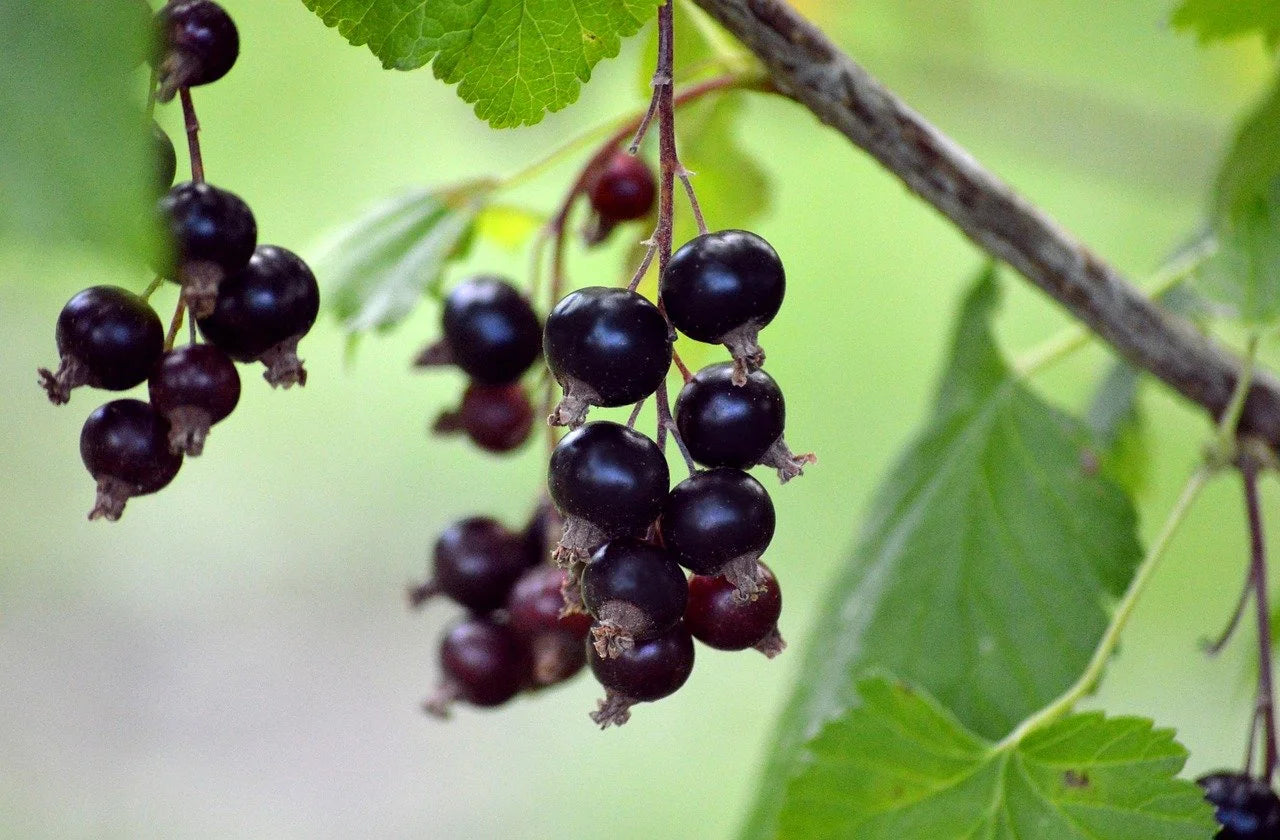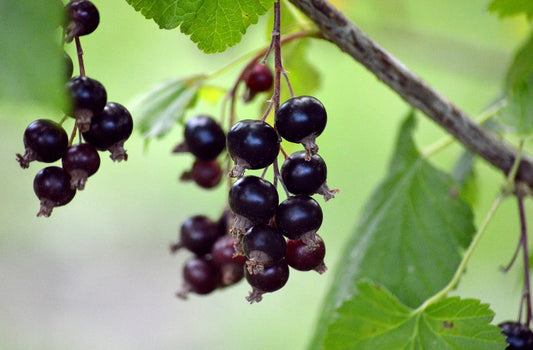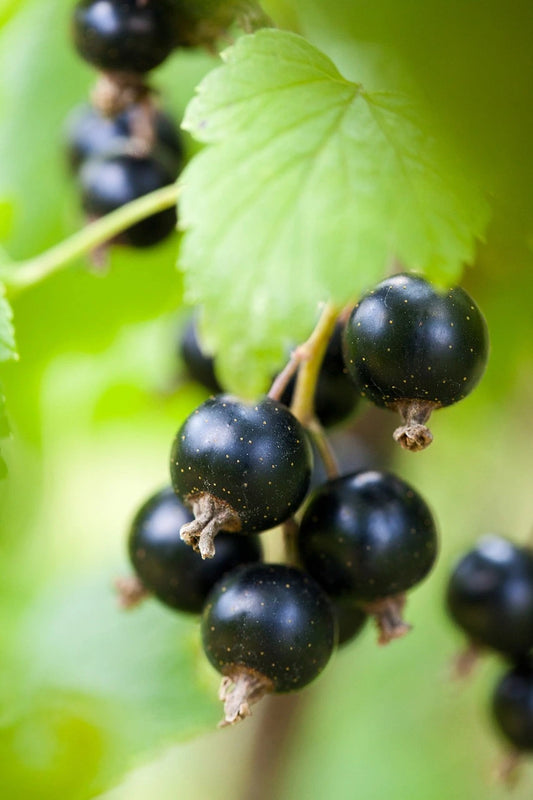-
Delivery from 10 plants within 15 days FR/ EU / CH
Delivery Terms -
Wholesale Supplier of Small Fruit Plants
About Us -
Quality Small Fruit Plants
Technical itinerary for small fruits -
Secure payment
Our Payment Terms
ORGANIC CASSISSIER White Cassis plant - 9 cm pot
ORGANIC CASSISSIER White Cassis plant - 9 cm pot
Price € excluding VAT per unit excluding transport. Our prices are based on volume. We offer you the best option based on your needs.
Couldn't load pickup availability
 Buy now and get it delivered when you're ready to plant - Add your desired date to your quote request
Buy now and get it delivered when you're ready to plant - Add your desired date to your quote request
 Delivery from 10 plants within 15 days FR/ EU / CH
Delivery from 10 plants within 15 days FR/ EU / CH
This plant is a small fruit plant in a 9 cm pot
This small fruit plant is stored in a 9 cm square horticultural pot. These plants are robust because they are more mature than the majority of plants in the range (smaller pot or bare-root). The pot packaging allows the plant to store water and nutrients and thus allows storage before planting in the ground. However, excessive storage should be avoided to prevent the roots from twisting, which would reduce the plant's ability to recover.
Ces plants de petits fruits pour professionnels sont certifiés Bio AB
Acheter des plants de petits fruits professionnels Bio AB vous permet de produire en Bio. Les Fruits peuvent être vendus en Bio
Quand Planter / Quand Récoler les Cassis ?
Vous souhaitez cultiver des Cassis mais vous ne savez pas quand les planter ? Vous souhaitez savoir quand vous allez récolter ? Consulter notre Calendrier de plantation et récolte pour les Cassissiers
View full details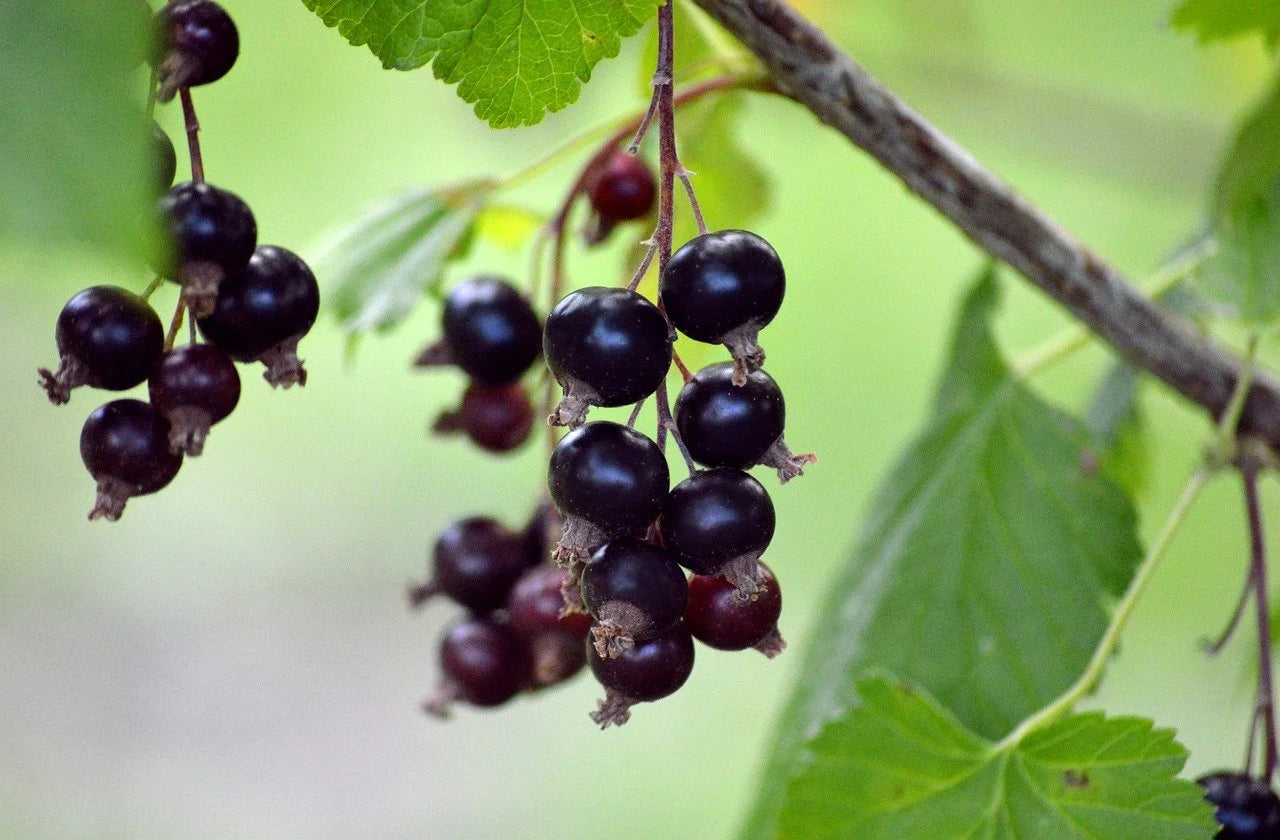
Our quality blackcurrants for professional market gardeners
Quick read / the essentials on Cassissier
The blackcurrant bush, also called Ribes nigrum , is a fruit shrub prized in France for both its fruits and its buds used in perfumery and gemmotherapy. Bairiverse, a specialist wholesale supplier of small fruit plants , offers a complete range of blackcurrant plants designed to meet the professional requirements of market gardeners and nurserymen. Whether you are looking for plants in horticultural pots, bare roots, pots or mini-plugs, you will find a solution adapted to all production models with us.
The range is available in organic, untreated and conventional plants, all from high-quality certified material, and available year-round. Choosing Bairiverse, a specialist wholesale supplier of small fruit plants , means opting for technical expertise in blackcurrant cultivation, an optimized delivery service for professionals, and personalized support. Thanks to our wide selection, you can buy blackcurrant plants according to your objectives: fruit production, processing (juices, liqueurs, jams) or growing high-value buds.
With only 62% of national demand covered, the development potential remains high, particularly in organic farming. As a specialist wholesale supplier of small fruit plants , we help you seize these opportunities with a variety catalog including references such as Noir de Bourgogne , Black Down or Andega . With Bairiverse, you can buy blackcurrant plants securely, in batches adapted to your areas, while benefiting from competitive prices. Whether you are growing for local markets, processing or export, we have the right solution for your technical itinerary. Don't wait any longer to buy blackcurrant plants from an expert, reliable and committed partner.
Presentation of our range of Blackcurrants
Bairiverse, a specialist in small fruit plants for professionals, offers a wide range of blackcurrant plants for market gardeners and nurserymen. Our plants are available in organic, conventional, and untreated varieties to meet the requirements of demanding growers. We offer:
- Wide range of blackcurrant plants in 7, 8 and 9 cm horticultural pots, perfect for short supply chains or direct sales in nurseries
- Wide range of blackcurrant plants in mini-plugs packaged in trays of 77 units, ideal for large mechanized plantations
- Wide range of blackcurrant plants in 1 to 4 litre pots for optimal rooting and planting in any season
- Wide range of bare-root blackcurrant plants, particularly suitable for autumn and winter planting
- Wide range of blackcurrant plants ready to repot, for flexibility in nursery or production management
Our catalog includes professional-quality blackcurrant plants, available year-round and suitable for both fruit-bearing and bud-producing plantations. All our plants can be delivered directly to your farm with personalized technical support.
Blackcurrant cultivation in France
Analysis of the Blackcurrant Market in France (2022-2025)
The French blackcurrant market has undergone significant changes in recent years, marked by structural challenges and emerging opportunities. This technical analysis aims to provide a precise overview of this sector for professionals wishing to invest in blackcurrant cultivation.
State of French production
Production has been unstable: 5,700 tonnes in 2020, 4,990 tonnes in 2021, then a sharp drop to 3,250 tonnes in 2022. An 18% recovery has since been observed. In a normal year, France produces around 7,000 tonnes on nearly 2,000 hectares.
Main production basins
- Loire Valley (40%)
- Burgundy
- Upper Rhone Valley
- Oise
Production structure
- Around 150 producers
- Burgundy-Franche-Comté: 880 ha (2019)
- Two major uses: fruit and bud (perfume, gemmotherapy)
Dominant varieties
- Burgundy Black (25%): perfumery, liqueurs
- Black Down (75%): pastry, juice, food processing
Market and opportunities
The crème de cassis market is in decline (-3%/year) while outlets are diversifying:
- Juices, jams, food supplements
- Organic and natural health products
- Modern cuisine and bud line
Self-supply rate
Estimated at 62%, indicating strong potential for French production in the face of imports
Current challenges
- Frost and drought by region (2022)
- Labor cost (80% of total)
- Massive disappearance of pollinators
- Need for varietal renewal
Perspectives and opportunities
- Organic buds: up to €120/kg
- Stable yield: 80 to 100 kg/ha
- Development of resistant varieties such as Andega (self-fertile, large fruits, good shelf life)
Our sales arguments
Delivery designed for blackcurrant producers
- Delivery to your plot or farm
- Delivery within 15 days in France and Europe
- Careful delivery with tailgate option available
Technical support dedicated to blackcurrant cultivation
- Responsive sales service: quote within 48 hours
- Personalized technical advice and adapted cultivation routes
- Dedicated technical support in season
A complete and competitive offer
- Organic, untreated or conventional blackcurrant plants
- The widest range of blackcurrant plants in France
- Decreasing pricing according to volume
- Producer price with excellent value for money
Bairiverse supports you in setting up your blackcurrant crops with a professional range designed for the requirements of market gardeners and nurserymen.
Cassissier: Complete Technical Guide for Cultural Professionals in France
Botanical presentation of Ribes nigrum
Blackcurrant ( Ribes nigrum ) is a fruit shrub belonging to the Grossulariaceae family. Native to Europe, it is mainly cultivated for its black berries rich in antioxidants, intended for food processing (crème de cassis, syrups, confectionery, pastries) or for fresh consumption.
Economic importance and prospects
In France, blackcurrant cultivation remains strategic , particularly in Burgundy. However, national production only covers 38% of demand , thus opening up considerable development opportunities for producers, particularly in the organic and processed sector.
Varietal choice and plant quality
Recommended varieties according to objectives
The choice of variety directly influences:
- Disease resistance
- The yield
- Organoleptic quality
Some examples:
- Noir de Bourgogne : very aromatic, ideal for processing
- Titania : resistant to powdery mildew and blister rust
- Andega, Ometa : self-fertile and productive
Importance of certified plant material
Professionals should use:
- Plants certified virus-free
- Aged 1 to 2 years
- With a well-developed root system
Healthy equipment improves recovery, reduces losses and optimizes yield.
Costs and comparison of organic/conventional
- Conventional plant : €0.75 to €1.70 excluding VAT/unit
- Certified organic : 10 to 20% more expensive
A higher initial investment in organic, but often offset by a higher value of the finished product .
Growing conditions for blackcurrant
Soil preparation and organic matter requirements
Recommended preparation:
- Deep plowing : 30-40 cm
- Compost/manure inputs : 30 to 50 t/ha
- Optimal pH: 6.0 to 7.0
- Organic matter rate ≥ 3%
Drainage is essential : shaping into ridges, perforated drain every 8-12 m, depth 80-100 cm.
Climate, exposure and choice of site
- Minimum 6 hours of sunshine per day
- Avoid wet lowlands and frost-prone areas
- Site selection = key to long-term success
Planting density and spacing
- Classic spacing: 1 to 1.5 m in the row / 2 to 2.5 m between rows
- For mechanized harvesting: 0.7-0.8 m in the row / 3-3.5 m between rows
- Density: 3000 to 5000 plants/ha
Irrigation and fertilization management
Water needs and efficient systems
- Recommended system: drip
- Water requirement: 3 mm/day/plant (from flowering to harvest)
- Yield increased by 20 to 50% thanks to irrigation
- Automated irrigation optimizes time and resources
Fertilization strategies (organic and conventional)
- Conventional: Balanced NPK
- 80-120 kg/ha of N
- 60-80 kg/ha of P₂O₅
- 100-140 kg/ha of K₂O
- Organic: compost, composted manure, green manure
- Biostimulants authorized in organic and conventional production
Pollination of blackcurrant
Self-fertile vs. self-sterile varieties
- Old varieties : self-sterile, require cross-pollination
- Modern : often self-fertile, but varietal diversity increases yield
Recommended ratio: 1 pollinator plant for 3 to 4 productive plants
Role of bumblebees and favorable arrangements
- Bumblebees = very efficient pollinators
- Recommended practices:
- Flowering hedges
- Insect hotels
- Reduction of chemical inputs
Optimized pollination improves yield and harvest consistency .
To summarize: Blackcurrant
Blackcurrant cultivation represents a strategic and rapidly evolving sector for French producers. Whether for food processing, perfumery or gemmotherapy, the opportunities are numerous and constantly evolving. Bairiverse positions itself as a specialist wholesale supplier of small fruit plants with a range of blackcurrant bushes perfectly adapted to the realities of the field. Thanks to our expertise, we support professionals in the choice of varieties – such as Noir de Bourgogne , Titania , Andega or Ometa – according to their production objectives.
As a specialist wholesale supplier of small fruit plants , we guarantee certified plant material, available in different packaging: bare roots for winter, pots for year-round planting, mini-plugs for mechanization, or even plants ready to repot. All our blackcurrant plants are carefully selected for their vigor, disease resistance and yield potential. Whether you are targeting the organic market, direct sales or industrial processing, you can buy blackcurrant plants from Bairiverse with the guarantee of tailor-made support.
Our customers also benefit from a dedicated technical service, personalized growing advice, and logistics designed for farms. By choosing to buy blackcurrant plants from Bairiverse, you benefit from volume-based pricing, annual availability, and excellent value for money. In addition, our commercial responsiveness allows you to obtain a quote within 48 hours, with rapid delivery to your plot. For a more resilient, profitable, and sustainable blackcurrant sector, trust Bairiverse, your specialist wholesale supplier of small fruit plants . It has never been easier or safer to buy blackcurrant plants wholesale to structure or develop your orchard.
-
Ben Alder bare-root blackcurrant plant 1 branch
Regular price €0,75 EURRegular priceUnit price / per -
Ben Lomond bare-root blackcurrant plant 1 branch
Regular price €0,75 EURRegular priceUnit price / per -
Ben Nevis bare-root blackcurrant plant 1 branch
Regular price €0,75 EURRegular priceUnit price / per -
Ben Sarek bare-root blackcurrant plant, 1 branch
Regular price €0,75 EURRegular priceUnit price / per
Additional / Useful information:
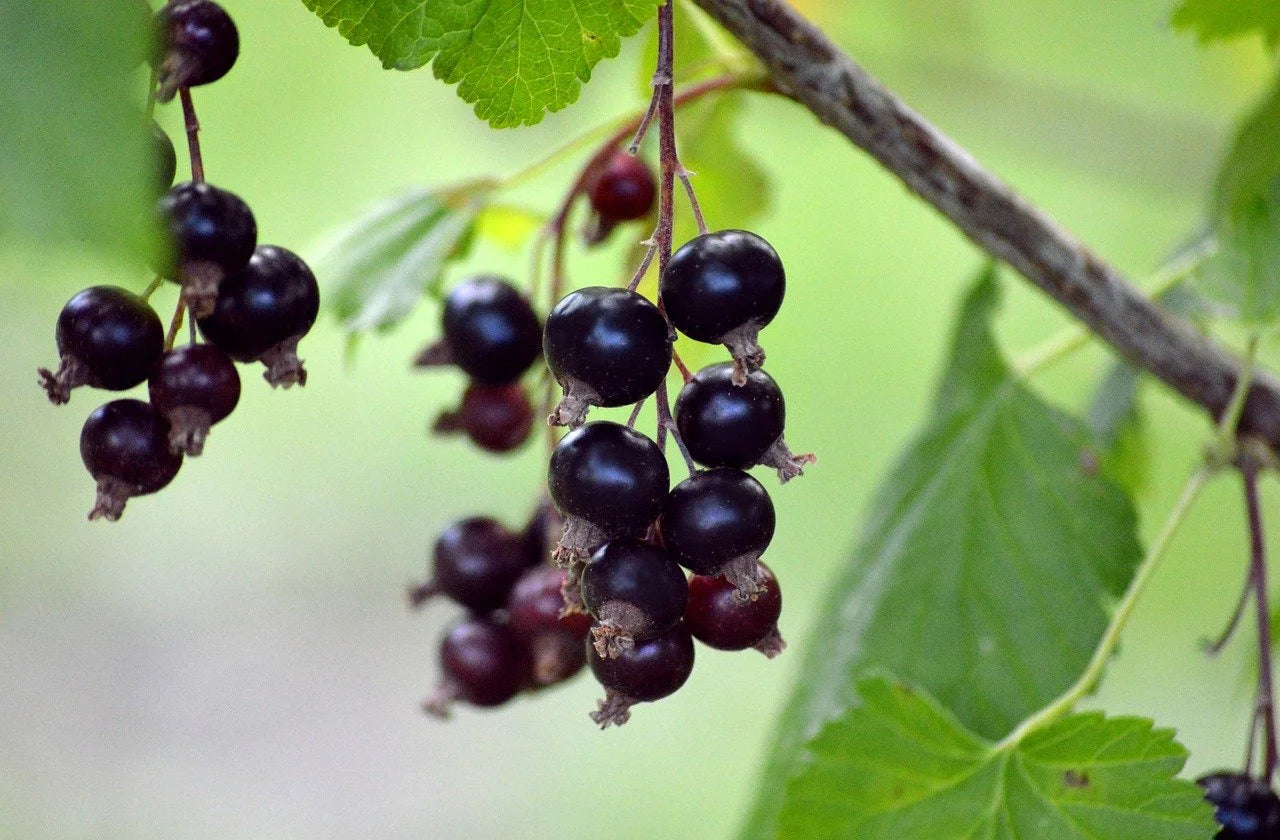
Which variety of blackcurrant should you choose? Characteristics and uses of blackcurrants
How to choose your blackcurrant variety?
Do you want to plant blackcurrant bushes on your plot but don't know which blackcurrant variety to choose? This blackcurrant variety guide lists the main varieties along with their characteristics and uses. For farm sales, supermarket sales, or processing? There's something for everyone.
If you are looking for another variety of Blackcurrant , do not hesitate to contact us: contact us
Our ranges of Blackcurrants:
Organic Blackcurrant and Gooseberry Range for Professionals
Conventional Blackcurrant and Gooseberry Range for Professionals
Blackcurrant Variety Guides:
| Variety | Color of the Fruits |
Remontante | Precocity | Productivity | Fruit Size / Shape | Disease Resistance / Hardiness | Fruiting Period | Taste | Self-fertile |
|---|---|---|---|---|---|---|---|---|---|
| Andega | Black | Non-Rising | Mid-Late | High yield | Large fruits | Powdery mildew tolerant | July to August | Firm, aromatic flesh, few seeds | Self-fertile. Produces abundant pollen. |
| Arno | Dark blue | Non-Rising | Early | Classic | Large fruits | Resistant to powdery mildew | June | Sweet flavor | Self-fertile |
| Bigno | Black | Non-Rising | Season | Average Yield | Big Fruits | Resistant to powdery mildew | End of June to beginning of July | Slightly acidic. Used in freezing or for its buds in medicine. | |
| Blackdown | Dark black | Non-Rising | Mid-Late | Good performance | Classic | Vigorous, adapts to all regions. Very good disease resistance. | End of July | Withstands cooking without bursting, perfect for processing | Self-fertile |
| Black Burgundy | Black | Non-Rising | Late | Fairly low yield | Average | Susceptible to powdery mildew | Mid-July | Perfect for processing into alcohol. Firm. Great aromatic richness. | Self-sterile. Requires pollinator such as Andega or Boskoop's Giant |
| Royal of Naples | Dark Blue to Black | Non-Rising | Late | Average | Quite small | Little susceptible to powdery mildew | Mid-July | Paired with Noir de Bourgogne for liqueur, very tangy | Self-sterile. Pollinated by Blackdow |
| Tradimel | Black | Non-Rising | Season | Very good productivity | Quite big | Susceptible to powdery mildew | July | Strong acidity, leaf can be used for herbal tea | Self-fertile |
| Boskoop Giant | Glossy black | Non-Rising | Early | Excellent performance | Large sweet fruits | Very susceptible to powdery mildew and anthracnose | End of June to beginning of July | Mild flavor, sweet and juicy pulp | Self-sterile. Pollinator of Noir de Bourgogne, must be pollinated by Andega |
| Ben Alder | Dark black | Non-Rising | Season | Very high yield, widely used on large plots for processing into wine | Small to medium sized berries, upright habit | Good resistance to mildew. Very hardy, good resistance to cold. Remains attached for a short period. | July to August | Perfect variety for juices and wines | Self-fertile but better fruiting if crossed |
| Ben Connan | Dark black | Non-Rising | Mid-Late | Abundant production (up to 3.5KG per plant at maturity) | Large berries. Medium-long stem. | Very disease resistant, one of the hardiest varieties | Mid-July to Mid-August | Perfect variety for berry juice, excellent flavor | Self-fertile but better fruiting if crossed |
| Ben Lomond | Dark black | Non-Rising | Mid-Late | Very abundant production of large berries | Very large fruits. Upright and compact bush shape. | Very resistant to frost and powdery mildew | Mid-July to Mid-August | Delicious and sweet | Self-fertile but better fruiting if crossed |
| Ben Nevis | Dark black | Non-Rising | Mid-Late | Very high yield. Only slightly lower than Ben Lomond but easier to pick. | Large, fragrant fruits. Very upright and vigorous bush. | Resistant to major diseases. Hardy | Mid-July to Mid-August (just before Ben Lomond) | Excellent flavor. The fruits are suitable for all uses. | Self-fertile but better fruiting if crossed |
| Ben Sarek | Dark black | Non-Rising | Mid-Early | Very large harvest volume. Scottish variety that offers the highest yield (by quite a distance). The yield potential is exceptional. | Large berries | Very tolerant of frost and cold. The only drawback is that the branch can break under the weight of the fruit. | Mid-June | Excellent flavor. Suitable for processing and direct sale. | Self-fertile but better fruiting if crossed |
| Big Ben | Glossy black | Non-Rising | Season | High yield. Large harvest, up to 4.5 kg per bush. | Fruit 2X larger than average (2.9G), making it one of the varieties with the largest fruits. Equivalent to Chandler for Blueberries | Resistant to mildew and leaf spots | Start to End of July | Very sweet fruit. Ideal for fresh consumption. | Self-fertile but better fruiting if crossed |
| Hedda | Glossy black | Non-Rising | Mid-Early | Offers high yields with ease of maintenance | Spherical, medium-sized fruit | Resistant to all diseases except powdery mildew, to which it is slightly susceptible. Very hardy, lasting down to -34°C. Its hardiness makes it easy to maintain. | Start to mid-July | The sweetest blackcurrant variety. Perfect for juice, jam, or jelly. | Self-fertile but better fruiting if crossed |
| Silvergieter's Black | Dark black | Non-Rising | Early | Fairly decent performance | Medium-sized fruit | Susceptible to mildew and rust | End of June to mid-July | Taste of a mild acidity. Use: raw, jelly, jam, compote, juice, wine, liqueur | Self-fertile but better fruiting if crossed |
| Titania | Glossy black | Non-Rising | Mid-Late | Very productive variety (up to 4KG per plant) | Large bunches but medium-sized berries | Good disease resistance, very cold resistant (down to -29°C) | End of July to mid-August | Very suitable for making jam, juice, pie or wine. Do not pick too early as it will have a very acidic taste. | Self-fertile but better fruiting if crossed |
| Wellington XXX | Glossy black | Non-Rising | Mid-Early | Variety with high productivity | Very large berries with very thick skin | Highly disease resistant. Mildew resistant. Good resistance to high temperatures. Suitable for warm regions. | Mid-June to early July | Very juicy variety. Perfect for making juice or jam. Sweet and fragrant pulp. | Self-fertile but better fruiting if crossed |
Planting and harvesting calendar for blackcurrant bushes
When to plant blackcurrant bushes? When to harvest blackcurrants?
Do you want to start growing blackcurrants but don't know when to plant them? Do you also want to know when you'll be harvesting them?
On this page you will find the planting and harvesting periods for each variety of Blackcurrant.
| Blackcurrant | Jan | Feb | Mar | Apr | May | Jul | Jul | Aug | Sep | Oct | Nov | Dec | Harvest rate / Production yield | |||||||||||||
|---|---|---|---|---|---|---|---|---|---|---|---|---|---|---|---|---|---|---|---|---|---|---|---|---|---|---|
|
Blackcurrant Andega |
Planting | 1 year after planting: small harvest 2 years after planting: first yield |
||||||||||||||||||||||||
| Harvest | ||||||||||||||||||||||||||
|
Blackcurrant Arno |
Planting | 1 year after planting: small harvest 2 years after planting: first yield |
||||||||||||||||||||||||
| Harvest | ||||||||||||||||||||||||||
|
Blackcurrant Bigno |
Planting | 1 year after planting: small harvest 2 years after planting: first yield |
||||||||||||||||||||||||
| Harvest | ||||||||||||||||||||||||||
|
Blackcurrant Blackdown |
Planting | 1 year after planting: small harvest 2 years after planting: first yield |
||||||||||||||||||||||||
| Harvest | ||||||||||||||||||||||||||
|
Blackcurrant from Burgundy |
Planting | 1 year after planting: small harvest 2 years after planting: first yield |
||||||||||||||||||||||||
| Harvest | ||||||||||||||||||||||||||
|
Royal Blackcurrant from Naples |
Planting | 1 year after planting: small harvest 2 years after planting: first yield |
||||||||||||||||||||||||
| Harvest | ||||||||||||||||||||||||||
|
Blackcurrant Tradimel |
Planting | 1 year after planting: small harvest 2 years after planting: first yield |
||||||||||||||||||||||||
| Harvest | ||||||||||||||||||||||||||
|
Giant Blackcurrant Bush from Boskoop |
Planting | 1 year after planting: small harvest 2 years after planting: first yield |
||||||||||||||||||||||||
| Harvest | ||||||||||||||||||||||||||
|
Blackcurrant Ben Alder |
Planting | 1 year after planting: small harvest 2 years after planting: first yield |
||||||||||||||||||||||||
| Harvest | ||||||||||||||||||||||||||
|
Blackcurrant Ben Connan |
Planting | 1 year after planting: small harvest 2 years after planting: first yield |
||||||||||||||||||||||||
| Harvest | ||||||||||||||||||||||||||
|
Blackcurrant Ben Lomond |
Planting | 1 year after planting: small harvest 2 years after planting: first yield |
||||||||||||||||||||||||
| Harvest | ||||||||||||||||||||||||||
|
Blackcurrant Ben Nevis |
Planting | 1 year after planting: small harvest 2 years after planting: first yield |
||||||||||||||||||||||||
| Harvest | ||||||||||||||||||||||||||
|
Blackcurrant Ben Sarek |
Planting | 1 year after planting: small harvest 2 years after planting: first yield |
||||||||||||||||||||||||
| Harvest | ||||||||||||||||||||||||||
|
Blackcurrant Big Ben |
Planting | 1 year after planting: small harvest 2 years after planting: first yield |
||||||||||||||||||||||||
| Harvest | ||||||||||||||||||||||||||
|
Blackcurrant Hedda |
Planting | 1 year after planting: small harvest 2 years after planting: first yield |
||||||||||||||||||||||||
| Harvest | ||||||||||||||||||||||||||
|
Blackcurrant Silvergieter's Black |
Planting | 1 year after planting: small harvest 2 years after planting: first yield |
||||||||||||||||||||||||
| Harvest | ||||||||||||||||||||||||||
|
Blackcurrant Titania |
Planting | 1 year after planting: small harvest 2 years after planting: first yield |
||||||||||||||||||||||||
| Harvest | ||||||||||||||||||||||||||
| Cassissier Wellington XXX | Planting | 1 year after planting: small harvest 2 years after planting: first yield |
||||||||||||||||||||||||
| Harvest | ||||||||||||||||||||||||||
Andega blackcurrant: Planting and harvesting period
The Andega blackcurrant bush is planted from September to November or from February to May. The fruiting/harvesting period for the Andega blackcurrant bush is from July to August. The Andega blackcurrant bush is a non-remontant variety.
Arno Blackcurrant: Planting and Harvesting Period
The Arno blackcurrant bush is planted from September to November or from February to May. The fruiting/harvesting period for the Arno blackcurrant bush is in June. The Arno blackcurrant bush is a non-remontant variety.
Blackcurrant Bigno: Planting and harvesting period
The Bigno blackcurrant bush is planted from September to November or from February to May. The fruiting/harvesting period for the Bigno blackcurrant bush is from late June to early July. The Bigno blackcurrant bush is a non-remontant variety.
Blackdown Blackcurrant: Planting and Harvesting Period
Blackdown blackcurrant is planted from September to November or from February to May. The fruiting/harvesting period for Blackdown blackcurrant is the end of July. Blackdown blackcurrant is a non-remontant variety.
Blackcurrant of Burgundy: Planting and harvesting period
The Black Burgundy Blackcurrant is planted from September to November or from February to May. The fruiting/harvesting period for the Black Burgundy Blackcurrant is mid-July. The Black Burgundy Blackcurrant is a non-remontant variety.
Royal Blackcurrant of Naples: Planting and harvesting period
The Royal Neapolitan Blackcurrant is planted from September to November or from February to May. The fruiting/harvesting period for the Royal Neapolitan Blackcurrant is mid-July. The Royal Neapolitan Blackcurrant is a non-remontant variety.
Tradimel Blackcurrant: Planting and harvesting period
The Tradimel Blackcurrant is planted from September to November or from February to May. The fruiting/harvesting period for the Tradimel Blackcurrant is in July. The Tradimel Blackcurrant is a non-remontant variety.
Boskoop Giant Blackcurrant: Planting and Harvesting Period
The Boskoop Giant Blackcurrant is planted from September to November or from February to May. The fruiting/harvesting period of the Boskoop Giant Blackcurrant is from late June to early July. The Boskoop Giant Blackcurrant is a non-remontant variety.
Ben Alder Blackcurrant: Planting and Harvesting Period
The Ben Alder blackcurrant bush is planted from September to November or from February to May. The fruiting/harvesting period for the Ben Alder blackcurrant bush is from July to August. The Ben Alder blackcurrant bush is a non-remontant variety.
Ben Connan Blackcurrant: Planting and Harvesting Period
The Ben Connan blackcurrant bush is planted from September to November or from February to May. The fruiting/harvesting period for the Ben Connan blackcurrant bush is from mid-July to mid-August. The Ben Connan blackcurrant bush is a non-remontant variety.
Ben Lomond Blackcurrant: Planting and Harvesting Period
Ben Lomond Blackcurrant is planted from September to November or from February to May. The fruiting/harvesting period for Ben Lomond Blackcurrant is from mid-July to mid-August. Ben Lomond Blackcurrant is a non-remontant variety.
Ben Nevis Blackcurrant: Planting and Harvesting Period
Ben Nevis Blackcurrant is planted from September to November or from February to May. The fruiting/harvesting period for Ben Nevis Blackcurrant is from mid-July to mid-August (just before Ben Lomond). Ben Nevis Blackcurrant is a non-remontant variety.
Blackcurrant Ben Sarek: Planting and harvesting period
The Ben Sarek blackcurrant bush is planted from September to November or from February to May. The fruiting/harvesting period for the Ben Sarek blackcurrant bush is mid-June. The Ben Sarek blackcurrant bush is a non-remontant variety.
Big Ben Blackcurrant: Planting and Harvesting Period
The Big Ben blackcurrant bush is planted from September to November or from February to May. The fruiting/harvesting period for the Big Ben blackcurrant bush is from early to late July. The Big Ben blackcurrant bush is a non-remontant variety.
Blackcurrant Hedda: Planting and harvesting period
The Hedda blackcurrant bush is planted from September to November or from February to May. The fruiting/harvesting period for the Hedda blackcurrant bush is from early to mid-July. The Hedda blackcurrant bush is a non-remontant variety.
Blackcurrant Silvergieter's Zwarte: Planting and harvesting period
Silvergieter's Blackcurrant is planted from September to November or from February to May. The fruiting/harvesting period for Silvergieter's Blackcurrant is from late June to mid-July. Silvergieter's Blackcurrant is a non-remontant variety.
Blackcurrant Titania: Planting and harvesting period
The Titania blackcurrant bush is planted from September to November or from February to May. The fruiting/harvesting period for the Titania blackcurrant bush is from late July to mid-August. The Titania blackcurrant bush is a non-remontant variety.
Blackcurrant Wellington XXX: Planting and harvesting period
Blackcurrant Wellington XXX is planted from September to November or from February to May. The fruiting/harvesting period for Blackcurrant Wellington XXX is from mid-June to early July. Blackcurrant Wellington XXX is a non-remontant variety.
French Blackcurrant Market in 2025
In 2025, the blackcurrant market in France will be characterized by contrasting dynamics between conventional and organic sectors, with growing demand for local and sustainable products. Between diversification opportunities, agroecological innovations, and climate challenges, market gardeners can take advantage of this fruit, which has a wealth of diverse uses, while meeting consumer expectations for short supply chains and responsible practices.
Blackcurrant: Presentation and Uses
The blackcurrant (Ribes nigrum) is a fruit shrub of the Grossulariaceae family, native to Europe and northern Asia. It produces blackcurrant, a small black berry with smooth skin and a characteristic, slightly acidic and astringent taste . These fruits, rich in vitamins and antioxidants, are valued for their nutritional and medicinal properties .
In France, the main commercial uses of blackcurrant are:
- The production of liqueurs and crèmes de cassis, particularly for the production of kir
- The making of jams, jellies, syrups and juices
- Use in the food industry for dairy products, confectionery and infant formulas
- Extraction of essential oils for perfumery
- Herbal medicine, using leaves and fruits for their medicinal properties
Evolution of the Cassis Market
The French blackcurrant market has seen mixed developments in recent years. For the conventional market, cultivated areas have increased slightly, mainly in Bourgogne-Franche-Comté, which represents 44% of national production . However, volumes fluctuated due to climatic hazards. Regarding organic production, despite a general downward trend in conversion areas (-28% in 2022), the organic blackcurrant sector held up better thanks to sustained demand. Certified organic areas increased by 8%, reflecting growing consumer interest in local organic products.
- Conventional market: Slight increase in surface area, variable volumes
- Organic market: Growth in certified areas (+8%), decrease in conversions
- Burgundy-Franche-Comté: 44% of national production
- Growing demand for local and organic products
State of the Market 2025
The blackcurrant market in France in 2025 presents distinct trends between conventional and organic. In the conventional sector, there is a stabilization of cultivated areas, with approximately 3,000 hectares dedicated to blackcurrant production . Production volumes fluctuate around 10,000 tonnes per year, influenced by climatic conditions. The organic market, meanwhile, is experiencing moderate but constant growth. Certified organic blackcurrant areas increased by 5% compared to the previous year, reaching nearly 500 hectares . This increase is in line with the general trend in the organic sector, which now represents 10.4% of the French agricultural area . The growing demand for local and organic products is stimulating the development of short supply chains, particularly direct sales, which are seeing a 5% increase in the number of points of sale.
Regions and Terroirs Cassis
The main blackcurrant-producing regions in France are the Loire Valley (40% of national production), Burgundy, the Upper Rhône Valley and the Oise . Burgundy-Franche-Comté, the historic birthplace of blackcurrant, remains a dominant region with 44% of national production .
Each region has specific characteristics that are favorable to blackcurrant cultivation:
- Loire Valley: Temperate climate and well-drained clay-loam soils.
- Burgundy: Continental climate with cold winters, favorable to the dormancy of the blackcurrant bush. Limestone or marl soils, moderately deep and well drained .
- Upper Rhône Valley: Mediterranean to dry continental climate, with arid limestone soils .
- Oise: Degraded oceanic climate, suitable for growing blackcurrants .
Blackcurrant adapts well to cool, continental climates, requiring harsh winters for dormancy and resisting spring frosts .
Blackcurrant Growing Techniques
The main varieties of blackcurrant grown in France are Noir de Bourgogne , Andega , Titania and Ben Lomond . Blackcurrant adapts to a variety of soils but prefers fresh, moist, well-drained clay loams with an optimum pH of 6.0 . It requires a cool climate with harsh winters for dormancy .
Irrigation is crucial, especially during flowering and until flower bud initiation after harvest, with a need of approximately 25 mm of water per week . The recommended planting density is approximately 350 plants per 1000 m² . Average yields vary between 4 to 6 tonnes/ha in conventional farming and 3 to 4 tonnes/ha in organic farming . The blackcurrant bush comes into production after 2 years and can remain productive for more than 20 years with good maintenance .
International Blackcurrant Trade
France is the third largest producer of blackcurrants in Europe, behind Poland and the United Kingdom . However, French production, estimated at around 7,000 tonnes per year, remains modest on a global scale . Poland dominates the market with a production of 131,000 tonnes, followed by Russia which produces around 420,000 tonnes of blackcurrants and gooseberries combined .
French blackcurrant imports come mainly from Poland, which exports around 34,200 tonnes per year, including 1,400 tonnes to France . These imports, often in frozen form, compete directly with national production, particularly for supplying processing industries . This foreign competition puts pressure on the prices and margins of French producers, encouraging the sector to diversify towards products with higher added value such as purees, compotes and juices, which now represent 50% of outlets .
Cassis Market Opportunities
The blackcurrant market in France offers interesting opportunities for producers, both in the conventional and organic sectors. For the conventional market, the diversification of industrial outlets represents significant growth potential. While crème de cassis remains a flagship product, the growing demand for blackcurrant purees, compotes and juices opens up new perspectives . These processed products now represent 50% of outlets, offering greater added value to producers.
In the organic sector, growth is driven by increased consumer demand for local and sustainable products. Aid for organic conversion and support from regional institutions facilitate the transition to this mode of production . The specific demand for organic blackcurrants for the food supplement and natural cosmetics industry also offers high value-added opportunities. Producers can thus benefit from a rapidly expanding niche market, meeting consumer expectations in terms of health and well-being.
Profitability and Financial Aid
Blackcurrant production presents significant differences between conventional and organic methods, both in terms of costs and profitability. For installation, the total cost, including soil preparation, planting and irrigation, is estimated at approximately €8,307 per hectare . Annual maintenance and harvesting vary considerably: from €1,911 to €11,006 per hectare, depending on whether the harvest is mechanical or manual .
In terms of profitability, organic blackcurrants offer interesting prospects. With a planting density of around 350 plants per 1000 m², we can expect a yield of 600 kg and a potential gain of €3,100 for this area . Compared to other crops such as sunflower, whose average annual gross margin excluding aid is between €341/ha and €484/ha, blackcurrant appears to offer better potential profitability.
To support the transition to organic farming and diversification, several aid schemes are available. Conversion aid (CAB) and the Fonds Avenir Bio are interesting options for producers . Additionally, regional programs such as Rural Development Programs (RDPs) can offer additional support, particularly for agroecological practices such as hedge planting . Recently, an additional €15 million was allocated to support organic farms that have suffered economic losses, bringing the total aid to €105 million for 2024 .
Sector Challenges and Risks
The blackcurrant market, both conventional and organic, faces significant challenges. Conventional production faces strong international competition, particularly from Poland, which is putting pressure on prices . Climatic hazards, such as heat waves and violent storms, can cause production losses ranging from 30 to 70% depending on the plot . Phytosanitary risks are also a concern, with a limited number of products approved for crop protection .
For the organic market, the constraints are mainly linked to high production costs, resulting from a cultivation method that is more demanding in terms of labor and input management . Strict organic regulations, although a guarantee of quality, involve regular checks and costly certifications . Additionally, competition is intensifying in the organic market, with supply increasing faster than demand, which can put downward pressure on prices .
Innovations and Market Perspectives
The blackcurrant industry in France is moving towards more sustainable and innovative practices. Research is underway to develop varieties that are more resistant to disease and adapted to climate change . Agroecology is gaining ground, with the integration of cutting-edge technologies such as nanotechnology to optimize crops . Producers are exploring new outlets, particularly in the cosmetics and nutraceutical industries, to diversify their income .
In the medium term, the blackcurrant market is expected to experience moderate but stable growth. Demand for local and organic products will continue to increase, favoring short supply chains . Innovation in processed products, such as purees and functional juices, is expected to boost consumption . However, climate challenges and international competition will remain key factors to monitor for the French sector .
Recommendations for Market Gardeners
Blackcurrant cultivation presents interesting opportunities for French market gardeners, but requires careful consideration before committing to it.
Benefits :
- Growing demand for local and organic products
- Diversification of outlets (food industry, cosmetics, nutraceuticals)
- Good potential profitability, particularly in organic farming
- Adaptability to different French climates and soils
Disadvantages:
- Sensitivity to climatic hazards and phytosanitary risks
- Strong international competition, especially from Poland
- Significant initial investments (planting, irrigation)
- Strict regulations and high costs for organic products
Recommendations:
- Favor varieties adapted to the local terroir and resistant to diseases
- Adopting agroecological practices to strengthen crop resilience
- Diversify outlets by focusing on high added-value processing
- Consider gradual organic conversion to benefit from transition aid
- Integrate into local networks to optimize short-circuit marketing
A thorough analysis of the local market and available resources is essential before embarking on this promising but demanding crop.
Plants and Professional Advice
For market gardeners and professional producers looking for quality blackcurrant plants or advice on planting a plot, two specialist suppliers stand out on the French market:
Bairiverse ( https://plantspetitsfruits.com/ ) offers a wide range of small fruit plants, including blackcurrants, adapted to the needs of professionals . Their offer includes plants in mini-balls, pots and pots, available in organic and conventional versions . Bairiverse stands out for its commercial responsiveness and its fast delivery service within 15 days throughout France .
Econome à Légumes ( https://economealegumes.fr/ ) is a trader in plants and plant material offering competitive prices directly to producers . Their sales team is responsive and can be reached within 48 hours, providing personalized support for the choice of varieties and the establishment of crops . They also offer organic and conventional deliveries throughout France .
These two suppliers not only offer quality plants, but also technical support and advice tailored to blackcurrant plot planting projects, allowing producers to benefit from specialized expertise in the field of small fruits.
FAQ Small Fruits: all our planting tips
Find here all our technical itineraries and cultivation guides to optimize your berry yields
Maximize the production and quality of your crops with our technical itineraries
Whether you're a professional market gardener, nurseryman, or crop manager, accessing best practices and technical itineraries is essential to maximizing the yield and quality of your berry harvests. Through a selection of detailed articles and guides, you can benefit from advice on planting techniques, disease and pest management, as well as methods for preserving and optimizing production.
Explore each guide to get proven solutions, specific to the challenges of your operation, and benefit from the technical support of Bairiverse , your supplier of professional quality berry plants in France.
Raspberry bushes:
Which raspberry variety should you choose? Characteristics and uses of raspberry plants
Raspberry Planting and Harvesting Calendar
Blueberry bushes
Which blueberry variety should you choose? Characteristics and uses of blueberries
Planting and Harvesting Calendar for Blueberries
Definition: Blueberry varieties High Chill, Mid Chill, Low Chill and Rabbiteye
Mulberry trees
Which variety of mulberry should you choose? Characteristics and uses of mulberry trees
Planting and Harvesting Calendar for Mulberry Trees
Gooseberry Bushes
Which Variety of Gooseberries Should You Choose? Characteristics and Uses of Gooseberries
Planting and harvesting calendar for Gooseberries
Gooseberry bushes
Which variety of gooseberry should you choose? Characteristics and uses of gooseberries
Planting and Harvesting Calendar for Gooseberries
Blackcurrant bushes
Which variety of blackcurrant should you choose? Characteristics and uses of blackcurrants

